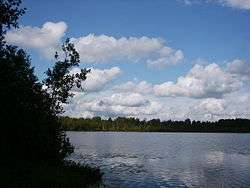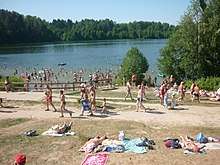Lake Svetloyar
Lake Svetloyar (Russian: Озеро Светлоя́р, romanized: ozero svetloyar) is a small, deep lake in the Voskresensky District of the Nizhny Novgorod Oblast in central Russia. It is located within the territory of the Voskresenskoe Povetluzhye Nature Park. The lake is classified as a Federal natural monument, and is projected to become part of Russian cultural heritage.[1] It is closely associated with the Legend of Kitezh, a sunken city.
| Lake Svetloyar | |
|---|---|
 | |
 Lake Svetloyar | |
| Location | Nizhny Novgorod |
| Coordinates | 56°49′07″N 45°05′35″E |
| Type | unknown |
| Native name | Светлояр (Russian) |
| Max. length | 0.5 kilometres (0.31 mi) |
| Max. width | 0.35 kilometres (0.22 mi) |
| Surface area | 0.1483 square kilometres (0.0573 sq mi) |
| Max. depth | 33.4 metres (110 ft) |
| Surface elevation | 109 metres (358 ft) |

Description
The lake is located between the Kerzhenets and Vetluga rivers, two tributaries of the Volga, in the "Voskresenskoe Povetluzhye".[lower-alpha 1] The area was declared a natural park in 2008. The lake is oval in shape (470 × 350 m) with the long axis aligned north-south. It reaches a depth of 33.4 m,[2] which differentiates it from neighbouring lakes. The deepest point is in the southern part of the lake, rising to a shallow platform, ranging in depth from 22 to 24 m. In the northern, relatively shallow part of the lake, the depth change is smoother compared to the southern part.
The height above sea level of the surface of the lake is 109 m. The shores of the lake are somewhat elevated, and the lake itself lays in a small basin. The hills encircling the lake are most distinctly manifested from the south, where they form an arc. The height of the hills reaches 122–124 m above sea level (13–15 m above the lake's water level) and are separated by deep (7–8 m) ravines.[2]
The lake's water is very pure and transparent to a depth of more than 5 m. The lake is cold, and fed by numerous bottom keys. The banks are weakly swamped.[2] To the north-east is the small, shallow Lunda River, from which the lake is connected by a stream. The runoff from the lake through the stream was disturbed during the construction of a road during the Soviet era. As a result, the lake began to swamp. Restoration of natural lake flow occurred in the 1990s.
The volume of the lake basin (not the lake itself) is about 1.5 km3, and the area of the lake itself is 14.83 hectares. The thickness of the bottom sediments is about 8 m.[2]
Origin
Various researchers at different times have hypothesized about the glacial, karstic, old, volcanic, neotectonic, salt-dome, and meteorite origin of the lake. The first explorer of the lake in the late 19th century was a Russian geologist, Vasily Dokuchaev, who suggested it was a meteorite crater. The volcanic origin of the lake was first suggested in the early 20th century by the writer Vladimir Korolenko. Amateur archaeologist A. P. Polivanov[3] conducted excavations on one of the Svetlogorsk hills and discovered the remains of ancient tools related to the Stone Age.
In 1969, under the leadership of Mark M. Barinov,[4] scuba divers using acoustical systems detailed the complex structure of the relief of the bottom of the lake. The central pit-hollow is fringed by a system of two underwater terraces, expanding in the northern and narrowing in the southern parts of the lake and having depths of 18-20 and 9–10 m, respectively. It was suggested that a multistage cyclic-periodic formation, very young in the scale of geological time, as a result of neotectonic processes. Based on this, it was concluded that the central basin was formed a little more than a millennium (about 1100–1200 years ago) in the form of a small lake with a depth of 15–17 m, and the immersion of the lower terrace occurred approximately 700–800 years ago.
Recently, a number of studies confirmed the meteorite hypothesis[5] of the origin of Svetloyar and some neighboring lakes. In 2009, the results of field studies bolstered the hypothesis of the meteorite origin of the lake, around 3 thousand years ago. The correct form, depth, the geological structure of the surrounding hills, the stratigraphy of bottom sediments, numerous fragments of fused rocks, rounded teardrop formations of a black foamed vitreous mass, analogous to impactites, attest to the meteorite origin of the lake. The heavenly body that created Svetloyar could move from north to south along a low trajectory at an angle of 30-40 ° to the Earth's surface.
Media coverage
In 1993, the creative association Ekran (Russian: Экран, romanized: Ekran, lit. 'Screen') released a film named "The Tale of the Great and Invisible City of Kitezh" (author and director V. Kukushkin), "about the mythological roots and the search for the invisible" City of Kitezh "under the smoothness of Lake Svetloyar in the Nizhny Novgorod region".[lower-alpha 2] The film was shown on the first channel of Central Television in Easter on April 17, 1993, before the first television broadcast of the Easter service from the Epiphany Cathedral in Moscow.
Notes and references
- В Нижегородской области озеро Светлояр могут причислить к культурному наследию Lake Svetloyar is considered for Cultural Heritage.
- Енгалычев С. Ю. Озеро Светлояр — голоценовый метеоритный кратер на востоке Нижегородской области Lake Svetloyar - Holocene meteorite crater in the east of the Nizhny Novgorod region // Regional geology and metallogeny. 2009 n°37 p.40—50.
- http://starina44.ru/polivanov-a-p-issledovanie-bogorodskago-gorodischa
- Barinov, M.M., 'The new worlds of underwater archaeology - diving into the past' , UNESCO Courier, May 1972 'Underwater Archaeology' (special issue), pp.5-7 - http://unesdoc.unesco.org/images/0007/000782/078276fo.pdf
- "The Lake Svetloyar". nashaplaneta.net. Retrieved 2019-07-31.
- the protection zone of the Nizhny Novgorod Povetluzhye, a nature park of regional significance
- description given by the site of the Radio and Television Fund of the Russian Federation